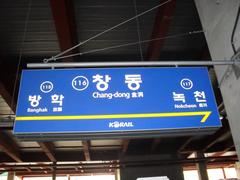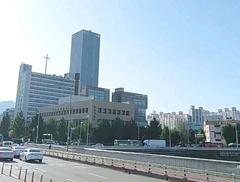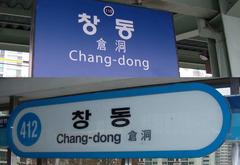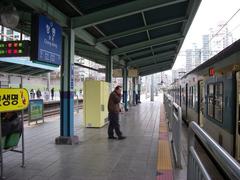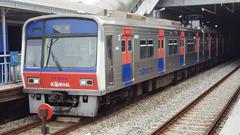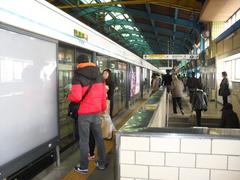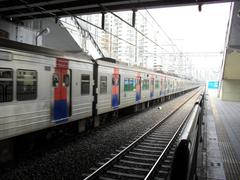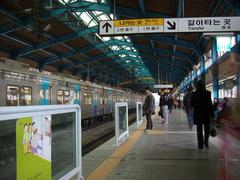
Chang-dong Station Visiting Hours, Tickets, and Travel Guide in Seoul
Date: 14/06/2025
Introduction
Chang-dong Station in Dobong-gu, northeastern Seoul, is a key transportation hub and a prime example of Seoul’s urban regeneration initiatives. Connecting Subway Lines 1 and 4, this station is not only a gateway for commuters but also a symbol of the city’s efforts to revitalize aging neighborhoods into vibrant cultural, economic, and residential centers. With innovative projects like Platform Chang-dong 61, the anticipated Seoul Arena Culture Complex, and a wide array of local attractions, Chang-dong Station is poised to become a must-visit destination for travelers seeking authentic experiences in Seoul.
This comprehensive guide explores the historical evolution, current redevelopment projects, practical visitor information, nearby attractions, and essential travel tips to help you make the most of your visit to Chang-dong Station.
Table of Contents
- Introduction
- Historical Context and Urban Regeneration
- Urban Renewal Phases and Major Projects
- Visitor Information
- Nearby Attractions
- Cultural and Social Impact
- Travel Tips and FAQs
- Conclusion
- Sources
Historical Context and Urban Regeneration
From Model New Town to Urban Stagnation
Chang-dong, originally developed as a model new town during South Korea’s rapid urbanization in the post-1980s era, quickly flourished with residential complexes and modern infrastructure. However, by the early 2000s, the area confronted economic and social stagnation. Key challenges included aging buildings, limited job opportunities, and physical barriers such as the railroad depot, which hampered connectivity and land use (Seoul Urban Regeneration Project PDF).
The Need for Urban Regeneration
Demographic shifts—such as an aging population and declining birth rates—highlighted the urgency of revitalizing Chang-dong. Seoul’s leadership responded with a comprehensive urban regeneration plan aimed at transforming Chang-dong and neighboring Sanggye into vibrant, sustainable communities by fostering economic growth, cultural vitality, and improved connectivity (Seoul Urban Regeneration Project PDF).
Urban Renewal Phases and Major Projects
Phase 1: Primer Projects
- Platform Chang-dong 61: This creative cultural complex, constructed from repurposed shipping containers, is located just steps from Exit 1. It features music venues, art workshops, community spaces, and food outlets, serving as a beacon for the area’s transformation (Platform Chang-dong 61).
- Northeast Startup Center: Fosters local entrepreneurship and innovation.
- 50+ Campus: Offers lifelong learning and community programs for residents aged 50 and above.
- Arts & Culture Themed Roads: Pedestrian-friendly routes lined with public art and creative industry hubs.
Phase 2: Economic and Cultural Anchors
- Seoul Arena Culture Complex: Set to become a landmark cultural venue, this arena will anchor Chang-dong’s new identity as a center for entertainment and the arts.
- Innovation and Commerce Hubs: Knowledge-based industry centers and commercial complexes will create new employment opportunities and diversify the local economy.
- Redeveloped Spaces: Areas reclaimed from the former railroad depot and test center will be repurposed for offices, retail, and mixed-use development, aiming to attract 1,000 businesses and generate 80,000 jobs (Platform Chang-dong 61).
Phase 3: Integrated Transportation and Connectivity
- Intermodal Transportation Center: Plans are underway to further integrate subway, bus, and regional rail at Chang-dong Station, improving access throughout Seoul and the metropolitan area (Seoul Urban Regeneration Project PDF).
Visitor Information
Station Facilities
Chang-dong Station is jointly operated by Korail and Seoul Metro and features:
- Multiple platforms: Easy transfers between Line 1 and Line 4.
- Automated ticketing: Purchase single-journey tickets or recharge T-money cards at kiosks.
- Restrooms: Modern, accessible facilities throughout the station.
- Customer service: Information desks with English-speaking staff during peak hours.
- Shops and amenities: Convenience stores, bakeries, ATMs, and lockers.
- Accessibility: Elevators, tactile paving, and ramps ensure barrier-free transit.
Operating Hours and Ticketing
- Station Hours: Open daily from approximately 5:30 AM to midnight. Train times may vary slightly by line.
- Ticketing Options:
- T-money Card: Recommended for convenient travel; available at kiosks and convenience stores (Wheretarawent).
- Single-journey tickets: Require a refundable KRW 500 deposit.
- Mpass: Offers unlimited rides for tourists over a set period.
- Fare Structure: Base fare covers up to 10 km; additional charges apply for longer distances.
Accessibility
- Barrier-free access: Elevators, escalators, tactile paving, and accessible restrooms.
- Assistance: Information desks and intercoms are available; the Seoul Danurim Accessible Tourism Center can arrange accessible transportation.
Local Transportation and Exits
- Subway connections: Lines 1 and 4, with direct access to central Seoul and northern districts.
- Korail services: Limited regional trains to northern cities.
- Bus and taxi links: City and intercity buses, as well as taxi stands, are located near station exits.
- Exits:
- Exit 1: Dobong-gu Office, local markets, bus stops.
- Exit 2: Residential neighborhoods.
- Exit 3: Chang-dong Art Village, cultural venues.
- Exit 4: Bus terminals, taxi stands.
Nearby Attractions
- Platform Chang-dong 61: Cultural complex for music, art, and food (Platform Chang-dong 61).
- Chang-dong Traditional Market: Dive into Seoul’s culinary culture with street foods like tteokbokki, hotteok, and mandu.
- Dobongsan Mountain: Popular hiking destination with scenic trails and temples (Visit Seoul - Dobongsan).
- Chang-dong Art Village: Galleries, cafes, and public art near Exit 3.
- Local Markets and Shops: Traditional goods, crafts, and fresh produce.
- Pojangmacha (Street Food Stalls): Evening street food scene with authentic Korean snacks.
- Bukhansan National Park: Outdoor activities and nature close by (Bukhansan National Park Information).
- Seoul Dream Forest: City park with gardens and walking paths (Seoul Dream Forest).
Cultural and Social Impact
Chang-dong’s regeneration aims for more than economic revitalization. Facilities like Platform Chang-dong 61 foster community engagement through music, art, and educational programs. The area’s unique character is maintained through themed roads, public art, and cultural festivals such as the Chang-dong Music Festival.
Initiatives like the 50+ Campus and local startup centers encourage lifelong learning and innovation, enriching the neighborhood’s social fabric and preserving its identity amidst modernization (Seoul Urban Regeneration Project PDF).
Travel Tips and FAQs
Visitor Tips
- Best times to visit: Weekdays for a quieter experience; weekends for lively markets and events.
- Payment: Credit cards are accepted in most places, but carry cash for small vendors and stalls.
- Language: Most signs are bilingual (Korean/English); translation apps can help.
- Safety: The area is safe with visible security and good lighting.
- Etiquette: Remove shoes in traditional settings and respect local customs.
Frequently Asked Questions
Q: What are Chang-dong Station’s operating hours?
A: Trains run from about 5:30 AM to midnight daily. Confirm exact times on the Seoul Metro website.
Q: How do I buy tickets?
A: Use kiosks or counters at the station. T-money cards provide the most convenience.
Q: Is the station accessible for people with disabilities?
A: Yes, all major facilities are barrier-free, with elevators, ramps, and accessible restrooms.
Q: Are there guided tours?
A: No official tours of the station, but cultural venues like Platform Chang-dong 61 occasionally offer workshops and events.
Q: Where can I find lockers or store luggage?
A: Lockers are available within the station concourse for short-term storage.
Conclusion
Chang-dong Station exemplifies Seoul’s forward-thinking urban renewal, blending cultural innovation, community engagement, and enhanced mobility. The multi-phase regeneration approach has transformed the area into a vibrant hub where tradition meets modernity. With easy access to cultural venues, local markets, and outdoor escapes, Chang-dong offers a rewarding, authentic Seoul experience for all travelers.
Stay updated on local events and travel tips through the Audiala app and official Seoul websites to make the most of your visit to this dynamic neighborhood.
Sources
- Seoul Urban Regeneration Project PDF
- Platform Chang-dong 61 Opened Aiming Emerging New Cultural Hotspot in Northwestern Seoul
- 7 Day Itinerary for Seoul, South Korea: How to Spend a Week in Seoul
- Seoul Metropolitan Government - Changdong-Sanggye Urban Regeneration
- Official Seoul Subway Website
- Bukhansan National Park Information
- Platform Changdong 61 - Visit Seoul
- Dobong-gu Official Website
- Visit Seoul - Dobongsan Mountain
- Seoul Dream Forest
